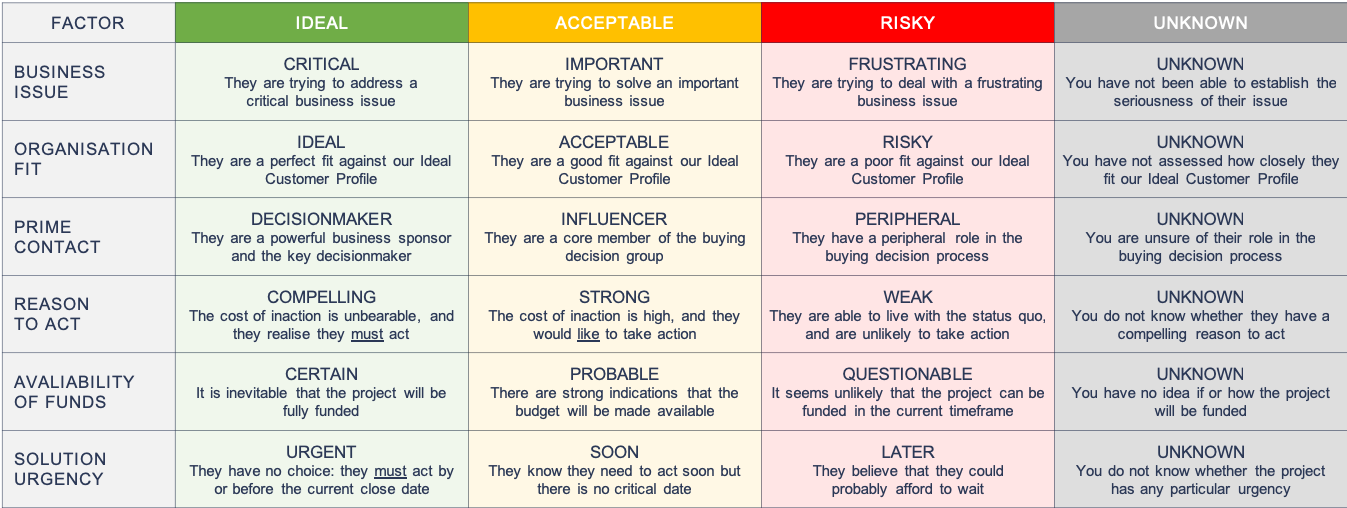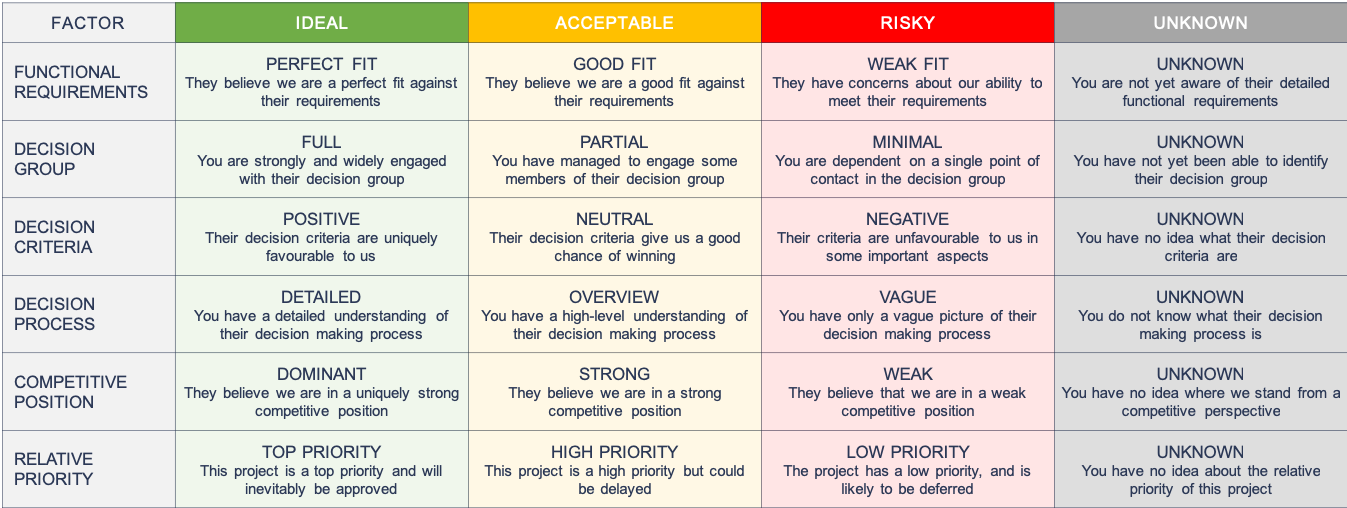
A progressive approach to qualification (that isn't BANT)
Like a growing number of other commentators, I have come to believe that the traditional BANT (Budget, Authority, Need and Timeframe) approach to sales opportunity qualification is fundamentally flawed and not fit for purpose when it comes to complex B2B sales.
The fact that over 40% of purchasing projects are ad-hoc rather than formally budgeted is, as I argued in a recent blog, yet another nail in the coffin of this outmoded and discredited methodology. But if not BANT, what can you use instead?
Any alternative approach has to take into account the fundamentally non-linear nature of B2B buying decisions, particularly when they relate to solving a new and unfamiliar problem (as opposed to repeat purchases of well-known commodities).
In such environments, opportunity qualification must be recognised and managed as a progressive rather than a one-off process - often starting with marketing, involving some form of tele-qualification and with responsibility passing to the sales person ultimately responsible for the opportunity.
In these complex, lengthy, multi-touch environments, it’s obviously important that everyone involved in the creation, qualification and management of sales opportunities shares a common perspective.
After evaluating hundreds of complex B2B sales environments, I’ve come to the conclusion that there are around a dozen consistent factors in the opportunity qualification process. Some are relatively obvious from the start of the engagement with a prospective customer - others only become clear after the customer’s buying decision journey has progressed.
For convenience, I’ll divide these 12 elements into initial and advanced qualification factors. Each of these factors needs to be regularly re-assessed throughout the lifecycle of the opportunity, particularly whenever the customer’s circumstances change.
After experimenting with a number of different approaches to evaluating each factor, I’ve concluded that a simple “traffic light” approach with three options (plus “unknown”) achieves the appropriate balance between simplicity, consistency and effectiveness:
- GREEN = a perfect fit against our qualification criteria
- AMBER = an acceptable fit against our qualification criteria
- RED = a risk factor or a negative fit against our qualification criteria
- GREY = unknown - we are currently unable to assess this factor
For each of the 12 factors, you need to establish a simple and consistent definition of what each of these levels of qualification means in practice in your environment. And I strongly recommend that when your sales people capture their current assessments in CRM that you require them to include a brief one-line commentary about how they arrived at their conclusion for each factor.
You also need to establish an atmosphere where it’s OK for your sales people to admit - rather than guessing - that they don’t have sufficient evidence to rate a factor as anything other than unknown (as long as the sales person then redoubles their efforts to get to the truth), and where it’s OK - and in fact highly desirable - to proactively qualify out a bad opportunity as early as possible in the cycle.
Let's start with the initial qualification factors:
INITIAL QUALIFICATION FACTORS

Business Issue
Has your customer acknowledged a clearly defined business issue that your organisation is really good at solving?
Organisation Fit
How closely is your prospective customer organisation aligned with your Ideal Customer Profile? If you haven’t established an Ideal Customer Profile, you need to!
Prime Contact
Is your prime contact the ultimate decision-maker, a powerful influencer or peripheral to the final decision? This is a critical consideration.
Reason to Act
Does your customer have a clear and compelling business justification to take action? This is typically far more important than having a vaguely defined “need”.
Availability of Funds
Is the customer ready, willing and able to fully fund the project? Note that the presence of a powerful budget shaper may be far more significant than the existence of a formally established budget
Solution Urgency
Is there a compelling reason why this project needs to happen now, rather than later (or at all)? Without urgency, even if they want you, they can probably wait.
The first three factors can often be established before a marketing-generated opportunity can be regarded as “sales ready”. All six factors should be established before you allocate significant resources to pursuing the opportunity.
Now let's turn to the remaining six advanced qualification factors:
ADVANCED QUALIFICATION FACTORS

The remaining factors typically require a significant level of involvement with the prospective customer before they can be accurately established.
Functional Requirements
What are the customer's functional requirements, and are they a good fit against our key capabilities? Hopefully you will have influenced them.
Decision Group
Have you identified and engaged all their key stakeholders, and what is your relationship with them? The decision group is usually larger than you might think!
Decision Criteria
What are their decision criteria, to what extent have you influenced them, and are they favourable to us?
Decision Process
Are you sure you have fully understood all the key steps in their decision process and timeframe?
Competitive Position
Are you sure you have identified all their other solution options, and do you know where you stand against them?
Relative Priority
How does this project rank against all the other projects competing for their attention/funding? This is frequently ignored but always important.
These remaining six advanced qualification criteria need to be assessed before any attempt is made to forecast the opportunity. And given the complexities of a typical lengthy B2B buying journey, and the fact that changes are nigh-on-inevitable, all twelve criteria need to be reassessed before an opportunity is promoted to the next stage of the pipeline or whenever the customer’s circumstances change.
BETTER THAN BANT
These 12 criteria, I hope you will agree, offer a far more complete and realistic assessment than BANT. And to anyone who think that 12 criteria are too many, I would simply ask you to consider whether any factor is unlikely to affect the outcome of an opportunity.
If it is genuinely irrelevant to your chances of winning the deal, you can safely leave it out of your qualification regime. But I’d encourage you think carefully before you hit the “delete” button. And, of course, there may be factors that are very specific to your typical sales situation that you will want to add.
CONSISTENT APPLICATION
Of course, what really matters is that your entire sales team consistently applies whatever qualification criteria you define, and that your sales managers are expected to evaluate the rigour with which their sales people are qualifying their opportunities.
If inconsistencies are common, you may need to refine exactly what you mean for each of the GREEN-AMBER-RED levels of each factor. And you may need to reaffirm that the purpose of qualification is not to make your sales people’s pipelines look good (for the moment, at least), but to help to ensure that they invest their precious selling time on opportunities that they have a realistic chance of winning.
And please don’t set arbitrary pipeline coverage targets that encourage sales people to cling on to opportunities that they should in all honesty have abandoned long ago.
A PROGRESSIVE APPROACH
So there you have it - my provably effective alternative to BANT. If you’re unconvinced, I suggest you try it. And don’t be surprised if your forecasts become a lot more accurate as a result.
To make your life easier, please check out my Membrain Edition, which embeds this methodology and helps your organisation get started quickly - with or without your existing CRM.

By Bob Apollo
Bob Apollo is the CEO at Inflexion-Point, the UK-based B2B sales and marketing performance improvement specialists. Inflexion-Point helps B2B organisations to design and implement highly effective customer acquisition systems based on a combination of the winning habits of their top sales performers and the latest industry best practices.
Inflexion-Point are the designers of the Outcome-Centric Selling Edition - a pre-configured Membrain version with sales process, methodology, and enablement embedded. This Edition will help your salespeople to make your way of selling into a competitive advantage.
Find out more about Bob Apollo on LinkedIn







